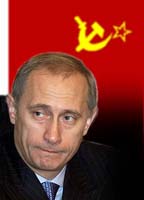Former Soviet Union republics owe $2 trillion to Russia
Where would all those countries be without the “Soviet occupation?” Obviously nowhere
Several republics of the former Soviet Union calculate the damage, which they suffered from the so-called “Soviet occupation.” Deputies of the Russian Federation parliament asked specialists of the Auditing Chamber to give their financial estimations of to how much money Russia could claim from the members of the former USSR in return. 
State Duma deputy, Viktor Alksnis, said that auditors could receive the information regarding the share of the three Baltic states (Lithuania, Latvia and Estonia) in the foreign debt of the USSR - $3.06 billion. The property of the Soviet Army, which was left in those countries, is evaluated in the sum of 32.2 billion rubles (according to the price level of 1991). In addition, Russia had to spend five billion rubles more on the deployment of military units which had been withdrawn from the above-mentioned states. It is worthy of note that the cost of the Russian ruble was equal to the cost of the US dollar in 1991.
Russia used to be the object of rapacious and cynical exploitation during the Soviet era. Seventy-five percent of the USSR's budget was made of assignments from the Russian Federation. The money was used for the development of economic systems of the Caucasus, Asia and the Baltic region.
The Baltic countries always took top positions of the list of Soviet investments. The government of the USSR used to invest billions of rubles in their economies: their debt to Russia was thus evaluated at $220 billion. The Soviet Union wanted to organize unique, elite and high-tech productions on their territories. The nuclear power plant, which was built in Lithuania at the expense of the USSR, still guarantees 60 percent of this country's demand in electric power. The ferry-boat communication with the German Democratic Republic cost some $3 billion; the airbase, which currently stations NATO bomber planes, cost one billion dollars.
About 28.3 billion rubles were invested in the economy of Georgia from 1935 to 1975. The cash flow was not interrupted in the republic even during the wartime years. According to official statistics of that period, the Georgian tea industry was manufacturing 82,5 thousand tons of tea a year in 1975 (the tea was consumed all across the USSR).
The republic of Armenia, which currently experiences serious problems with electric power supplies, left Italy behind in 1975 on the electric power production per capita. No wonder that electricity vanished in Armenia afterwards: there are hardly any mineral resources in the country.
A mammoth earthquake leveled Tashkent, the capital of the Uzbekistan republic, in 1966. A beautiful city appeared on the ruins of a sadly-looking town several years later: Russia recreated 664.8 thousand square meters of its territory.
The city of Baku, the capital of the Azerbaijan republic, used to be a fortress until a Russian merchant launched the development of the oil industry in the country.
Where would all those countries be without the “Soviet occupation?” Where did the industrial system of the Caucasus go after the collapse of the Soviet Union? They successfully destroyed the infrastructure that they inherited from the erstwhile superpower. To crown it all, the citizens of those republics still prefer to leave their homes and travel to the Russian Federation where they can earn some money.
Furthermore, Russia still has special prices for the former Soviet republics to purchase electric power, oil and gas. On the other hand, as soon as the Baltic states became EU members, they told Russia to buy their goods at standard European prices, in which discounts were excluded. According to expert estimates, up to 40 percent of the Latvian budget is formed with the help of Russian freight transits.
The USSR used to be formed around Russia. Russia did not occupy the neighbouring republics. Russia today is a piece of the Soviet Union, like any other republic, which used to be connected with it in the past. One may say that Russia did not have its present before the collapse of the USSR: there was no Russian Academy of Sciences, no institutes of Russian traditions, history and language, etc. There were not enough teachers in small Russian towns, because there was a strong lack of teachers in Uzbekistan, Kazakhstan, etc.
If all democratic countries, which used to be included in the structure of the Union of Soviet Socialist Republics, were asked to pay their debts to Russia, if one could expand it with the debt amounts, which Russia pays for them now to foreign creditors, they would have to return more than two trillion dollars.
Discuss this article on Pravda.Ru FORUM
Subscribe to Pravda.Ru Telegram channel, Facebook, RSS!





